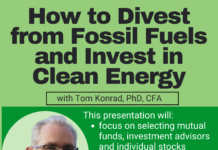UPDATE 3/4/2011: An up-to date article on selecting green mutual funds and ETFs can be found here.
Why Invest in Renewable Energy?
Given all the attention that renewable energy is getting in the news over the last couple years, investing in renewable energy has become a hot topic. People are drawn to renewable energy for one of several reasons:
- To fight Global Warming
- To prepare for Peak Oil.
- To improve Energy Security and local economies.
- To cash in on the above trends.
The beauty of investing in renewable energy companies is that these goals are not mutually exclusive. With one investment, the investor can feel good about what his money is doing for three reasons, while putting his money in what is proving to be a spectacular growth story.
Internet Bubble Redux?
To many, this sounds too good to be true. Many have pointed out the similarities between today’s renewable energy boom and the internet bubble of the late 1990s. The speculation has been intense, especially in ethanol and photovoltaic companies. And, similar to the internet craze, many of the companies are no-profit startups, and even the established companies with a solid record of profits trade at nosebleed price multiples. Yet the internet did not go away because the bubble burst; more people are shopping online and more business is moving online than ever before. Most likely, you are reading this article online… would you have been doing that in 1997? The forces behind the advance of renewable energy are at least as compelling as those behind the internet.
I believe that we are still in the early stages, but even so, we can learn valuable lessons from that last boom. One of the most important lessons is that the first mover does not always have the advantage, and often the winners are established companies that see the trend, and get on it in a measured way over time. But the analogy also has weaknesses. The internet was characterized by its low barriers to entry and exit, leading to cutthroat competition and me-too sites. With Renewable Energy companies operate mostly in a heavily regulated, capital intensive sector, a sharp contrast to the internet, which will likely make the boom happen in relative slow motion compared to the internet. I believe we’re much more likely to see a series of mini market bubbles during the ramp-up, than to see a single gigantic bubble, as we saw in the late 1990s.
How To Invest
For mutual fund investors, Renewable Energy focused mutual funds are few and far between. US investors are limited to the New Alternatives Fund (NALFX) and the Guinness Atkinson Alternative Energy Fund (GAAEX). The former has a 1.25% expense ratio despite the fact that it also has a front-end load, and while the latter is a no-load fund, its expense ratio is a pricey 1.98%. Given these high expenses, I strongly prefer the Powershares Wilderhill Clean Energy ETF (PBW) and NASDAQ Clean Edge U.S. Liquid Series ETF (QCLN). Both of these have expense ratios currently capped at 0.60%, which is high compared to a general energy sector ETF such as XLE (0.24%), but is a much more economical way to invest than the sector mutual funds.
Given the relatively high expenses of the sector ETFs, I believe it makes sense for investors who are looking to invest $25,000 or more in the sector for a period of years to build their own ETF from individual stocks gleaned from the holdings of the above ETFs and mutual funds. This also opens the possibility of focusing on established companies which are early movers into the renewable energy arena, a strategy which is less likely to lead to spectacular gains, but which also gives some protection against spectacular dot-com bust style losses.
Finally, I believe that, given the complex nature of the technologies, and the sparse coverage of many of the companies by industry analysts, there is still considerable room for active management in the sector. Given the emotional nature of the reasons for investing in Renewable Energy, a good understanding of practical behavioral finance, as well as an understanding of the technologies are likely to be necessities for success in the active management of an alternative energy portfolio.
DISCLAIMER: The information and trades provided here are for informational purposes only and are not a solicitation to buy or sell any of these securities. Investing involves substantial risk and you should evaluate your own risk levels before you make any investment. Past results are not an indication of future performance. Please take the time to read the full disclaimer here.









There is also GEX which is a ETF which mirrors the Ardour International Index for alternative energy products. GEX is new since about a month.
Very interesting, Ken. PBW and QCLN are fairly similar in their holdings, but GEX focusses on utilites, so is probably better for more cautious investors. It’s nice to see more of a variety to choose from.
Powershares will also be launching a new ETF (PBD) mirroring the Wilderhill new energy global innovation index by the end of this week. It may be seen as a direct competitor to GEX as both portfolios are very similar and focus primarily on the international alt energy sector. This may give alt energy investors more international exposure. And with the market currently having a little pullback, investors may just be able to find a good bargain on either ETF.